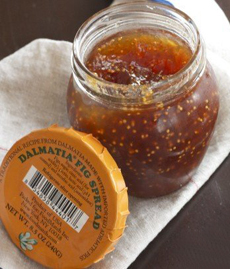TIP OF THE DAY: Fig Jam, Fig Chutney & More Figgy Condiments
Figs are hot and dry weather fruit—famously enjoyed for millennia in the Middle East, where it’s hot year-round.
In the U.S., figs grow in zones 8-10 (most of our figs are grown in California. They have two seasons: a shorter season in early summer and a second, main crop that starts in late summer and runs through fall.
Fig trees cannot withstand temperatures much below 20°F, and so are not grown in most of the Midwest and in the Northeast.
 Dalmatia Fig Spread. Photo courtesy TheKitchn.com. Here’s their review. |
So depending on your residence, you won’t find fresh figs; but you can console yourself with a jar of fig jam or chutney. Beyond spreading it on toast, here’s what you can do with it, courtesy of FrenchFarm.com, |
|
|
You can find Dalmatia Fig Spread (photo above)at many supermarkets, and other fig jams and chutneys at most specialty stores. But The French Farm has the biggest selection of fig condiments we’ve seen, any of which would make a lovely small gift or stocking stuffer for a foodie. The choices include: |
||
|
|
 Mustard with fig. Photo courtesy The French Farm. |
|
|
The edible fig was one of the first plants to be cultivated by humans. Fossils dating to about 9400–9200 B.C.E. in the Jordan Valley predate the domestication of barley, legumes, rye and wheat, and may thus be the first known instance of agriculture. Some botany historians propose that the figs may have been cultivated one thousand years before the next crops (wheat and rye) were domesticated. Much later in time, figs were a common food source for the Romans. Cato the Elder, in his De Agri Cultura, lists several strains of figs: the Mariscan, African, Herculanean, Saguntine and the black Tellanian. In addition to human consumption, figs were used, among other things, to fatten geese for the production of a precursor of foie gras. In ancient times, figs were cultivated from Afghanistan to Portugal to India. From the 15th century onwards, they spread to Europe and later, to the New World. [Source]
|
||


